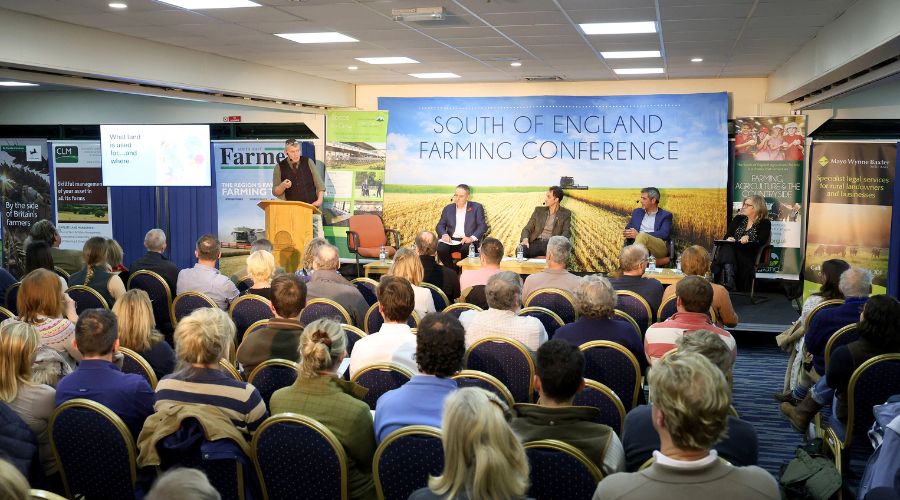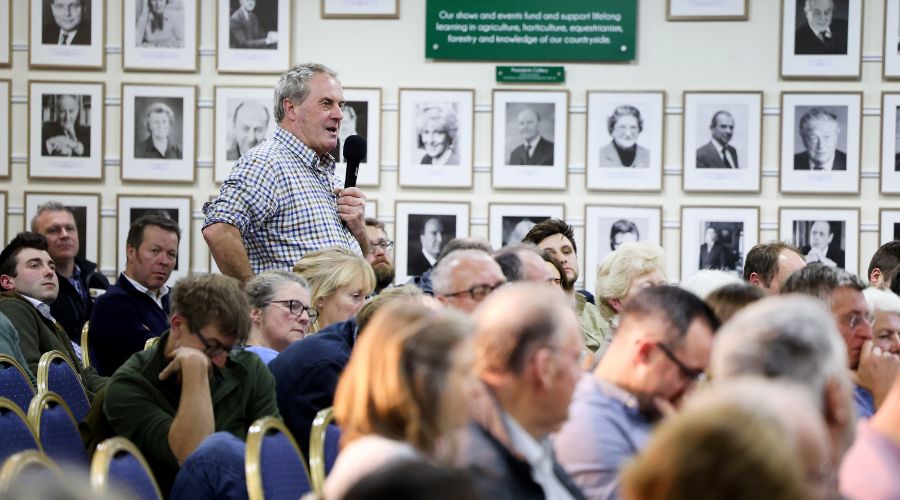South of England farming conference addresses crucial land use issues
25th November 2024
Last week, the South of England Agricultural Society hosted its annual farming conference. This year’s theme, ‘What is our land for?’ has sparked a lively debate on whether the focus of land use should shift from traditional food production to prioritising environmental and biodiversity goals or even to accommodate the demands of commercial development.

The event that was hosted at the South of England Showground has drawn record-breaking interest, with over 300 in-person and more than 200 online sign-ups.
Introduced by one of the society’s trustees, Mandy and Thomas Atkin, and chaired by BBC Radio 4’s Farming Today presenter Charlotte Smith, this year’s panel included Paul Christian, managing director of Sentry, Tom Heap, journalist and author, Tim Slaney, interim chief executive officer of the South Downs National Park Authority and Ben Taylor, managing director of Iford Estate.
Balancing agricultural productivity and environmental responsibility
Tom Heap began the discussion by presenting ideas from his latest book, Land Smart, which explores how land can support both people and nature. He described how UK land can help address numerous issues, such as “absorbing carbon, generating energy and storing floodwater,” alongside providing food and shelter.
He also stressed the need to keep the UK’s food footprint within its borders: “Pretty much rule one, if you don’t want to worsen climate change and nature loss, is not to take any more wild land into farming,” he said.
Mr Heap also advocated regenerative farming as a model for balancing agricultural productivity with environmental gains, defining it as a system that “leaves land in a better condition year after year.”
However, he warned against potential greenwashing, suggesting that regenerative farming requires careful management to ensure it genuinely improves the environment.
“The real trick is finding a way of producing the same amount of food without using the same level of chemicals,” he noted, emphasising the need to reduce reliance on synthetic inputs for sustainable productivity.
The role of food production and economic viability
Paul Christian, managing director of Sentry, then took to the podium to underscore the importance of sustaining local food production amid the UK’s evolving agricultural policies.
“I am here to make a stand for food production,” he stated, emphasising that farmers play an irreplaceable role in feeding the nation. He outlined the growing economic pressures, citing the need for clear government objectives as the farming sector navigates subsidy cuts and policy shifts.
“We’re producing food for 70 million people,” he remarked, cautioning against rhetoric that promotes vegetarianism without acknowledging the practical constraints of UK agriculture, such as its 13 million hectares of grassland.
Mr Christian was candid about the financial challenges, highlighting how rising operational costs and diminishing subsidies risk undermining the economic viability of UK farming.
He said: “I don’t see any hidden magic in the current changes that we’re being asked to do at the moment,” pointing to the disconnect between policy and on-the-ground realities.

Environmental stewardship in protected landscapes
Tim Slaney, CEO of the South Downs National Park, emphasised the unique role that protected landscapes like the South Downs play in balancing conservation with human access.
He advocated for a “nature permeable” approach to land management that integrates biodiversity and sustainable farming practices. “We’re in a biodiversity crisis,” Mr Slaney reminded the audience, noting that policies focused solely on food production are insufficient for sustainable land management.
Mr Slaney also pointed to initiatives like farming for protected landscapes and green finance as tools to help landowners meet conservation obligations within protected areas. He encouraged collaboration between landowners, suggesting that a stronger emphasis on the rural voice would be essential in future policymaking.
Alternative land uses and the growth of nature-focused enterprise
Last up to the podium was Ben Taylor, who manages the Iford Estate in Sussex. He shared how his estate has shifted from traditional farming towards biodiversity and eco-tourism to diversify revenue streams.
Mr Taylor described plans to devote around 800 hectares of his estate to biodiversity net gain (BNG), a scheme that allows developers to offset their environmental impact by investing in conservation efforts on his land.
He described the scheme as a promising but underfunded venture: “The big deals always seem to be just over the hill,” referencing the need for further investment to make BNG initiatives financially viable.
Mr Taylor shared his perspective on land’s purpose, emphasising economic resilience and adapting to market needs. “If my customers want nature and leisure space, then I’m only too happy to give them that,” he explained.
However, he also expressed frustration with the policy environment, suggesting that government actions do not prioritise food production: “I don’t wish to sound too gloomy, but I’ve been waiting 25 years now for some miracle to happen … I feel no moral obligation to [produce food] if my customers want nature.”
Audience engagement and broader reflections
A Q&A session with the audience was then opened, with many attendees raising issues about market dynamics, government support, and the public’s understanding of agriculture’s true costs.
One farmer from the audience asked, “Does the panel think that we can sustain the British government or the British people in the next five years of this government on honey and radishes?”
The question reflected concerns over the sustainability of relying heavily on environmental payments and reduced subsidies while maintaining food security.
Mr Heap responded by suggesting that society needs to rethink the value of food: “We should be paying the true cost of it, and that includes paying properly for a decent environment, decent nature, low carbon emissions, [and] a decent salary and living wage for the people who work on it as farmers.”

The future of UK land use
The conference concluded with reflections on the interconnected challenges of food production, environmental conservation, and public demand for natural spaces. The panel acknowledged that changes in climate, policy, and public opinion will continue to shape the future of land use.
Mr Christian underscored the unpredictability of climate impacts on farming: “The last three years, we’ve had climate issues with our harvest … We could be on the cusp of something.”
The discussion ended with a broad consensus on the need for a strategic land use framework that supports both the agricultural economy and environmental goals.
Mr Heap summarised this by reiterating the importance of pragmatic, multi-functional land-use strategies that balance productivity with conservation. He said: “Combine where possible – stack your land uses … There are some really, really clever people doing that today.”
The conference closed on a positive note, with panellists agreeing that addressing land use challenges will require innovation, collaboration and long-term planning.
Some key actionable resolutions included:
- Government-led land use framework: The panel agreed on the need for a land-use framework led by the government that balances agriculture, conservation and renewable energy. This would provide farmers with clear objectives, aiding long-term planning.
- Market stability and fair pricing: Paul Christian and Tom Heap stressed the importance of fair pricing mechanisms to ensure farmers are compensated fairly. Consumer education was identified as a key tactic to bridge the gap between food production costs and public perception.
- Consumer education and public understanding: To develop better public understanding of agriculture, Tim Slaney suggested introducing a natural history GCSE and investing in programmes to increase public awareness of farming’s true value.
- Supporting biodiversity and climate resilience: The panel highlighted initiatives like biodiversity net gain and carbon sequestration as viable revenue sources and tools for achieving environmental goals.
- Investing in health and wellbeing through nature: Panellists advocated for better public access to natural spaces on farms, with Tim Slaney proposing funding initiatives to support such efforts, linking land use directly to societal health benefits.
Read more farm business news.



